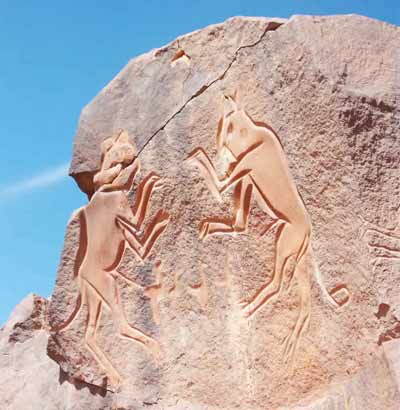Libyan art shares
influences with several cultures that have historically been in the area: Romans,
Ottomans, Arabs, Tuaregs, Berbers, Italians, and others. The earliest forms of
art are in the form of cave drawings found at a site near Awiss. These drawings
mostly show the hunt of animals and desert life. Really, what else is there?
(I’m joking.) Wadi Tidwa is known for its more bizarre rock carvings, and
archaeologists have thought that perhaps it’s related to some ancient religion
because, you know, religion can be bizarre sometimes. Other areas where rock
carvings have been found include Messak Settafet, Mellet, and Wadi
Matkhandoush. According to the Greek historian Herodotus, the Libyans invented
the wheel, and subsequently, there are about 500 examples of cave drawings of
chariots. (Yes, but are they on fire?)
 |
| It's supposed to be two cats fighting. They must've been able to see into the future and paint what I deal with every single day.. |
Many of their folk
art traditions are tied in with Islamic traditions. And per the Islamic
guideline that no figures or animals are to be depicted, Libyan crafts and folk
art do not have this either. Instead, geometric patters are used. Other crafts
and folk arts include embroidery and weaving, metal engraving, instrument making,
jewelry making (mostly out of leather, silver, and beads), and leatherwork.
 |
| Libyan Berber jewelry |
Art has long been
used as a means of expression and as a means of addressing issues that need to
be dealt with. Unfortunately, many of Libya’s artists left the country due to
the high level of censorship under the Gaddafi government. One artist is Aimen
Ajhani (aka El Bohly). He was instrumental as a graffiti artist, and often
created art with a political message. In Libya, he often faced arrest for his
craft, many times reported by people who didn’t understand what he was doing —
even after the war. I think that although most art was repressed for almost two
generations, now that we’re on the other side of the Civil War, artists are
finally starting to come out and be more open about it. The political situation
is still somewhat shaky, but I think it’s heading in the direction of getting
better. (Maybe? I hope?)
 |
| by El Bohly |
Libyan literature
stretches back thousands of years. Early Libyan literature was stemmed from its
oral poetry traditions. It didn’t have as much impact on early literature coming
out of the Arab Renaissance. However, its oral poetry strived, and it was this
medium that was used to express their unsavory sentiments during the Italian
occupation.
 |
| by Sadeq al-Neihum |
Modern Libyan literature
didn’t really get its momentum until after they gained their independence. Many
of the writers who rose to prominence during the 1960s wrote on progressive and
socialist views. Writers like Ali al-Regeie, Khamel al-Maghur, Sadeq al-Neihum,
Khalifa al-Fakhri, and Muhammad al-Shaltami followed these themes and were
widely read during this time.
These writers hit a
wall after Muammar Gaddafi took over. He set up one single state-owned
publishing house that everyone had to go through whether you liked it or not.
The state got to decide who and what got published. The ones who didn’t like it
were either imprisoned or just simply left the country. It was a rough time for
anyone in the arts, especially if your views were contrary to Gaddafi’s. After
the Civil War, however, this uber-conservative censorship was lifted, and
writers could freely write again. (More or less, I suppose.) Their constitution
made sure they wrote in freedom of the press. It’ll be interesting to see how
free their freedom of the press is as we continue to watch the changes in their
political situation.

No comments:
Post a Comment